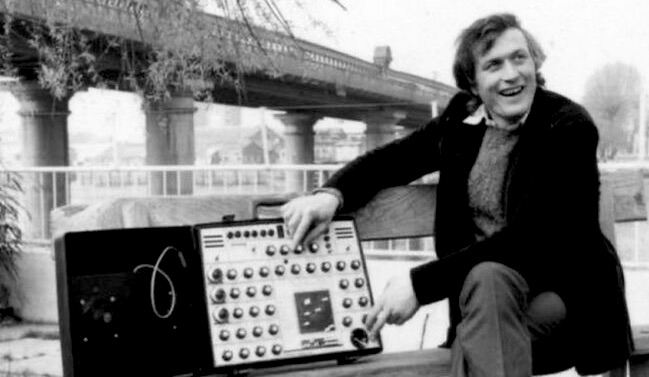
Thema on Wednesday 28 July 20:00 CET is dedicated to the British synthesizer pionier Peter Zinovieff.
Peter Zinovieff passed away on June 23 at the age of 88.
The Beatles, Pink Floyd, Kraftwerk, Brian Eno, BBC Radiophonic Workshop, Tangerine Dream, Jean-Michel Jarre, Aphex Twin, but also less well-known artists as White Noise, Merzbow, Coil, Meat Beat Manifesto, Scanner and Sarah Davachi (yes, the list is long), all used Zinovieff’s EMS Synths.
Peter Zinovieff was born on January 26, 1933 in London. In the early 1960s, he was a researcher at Bell Labs working under the auspices of pioneering computer musician Max Mathews and composer Jean-Claude Risset. This research work was followed by an MIT thesis that was approved by physicist and inventor David Alan Luce.
Between 1966–67, he formed Unit Delta Plus, an organisation dedicated to creating and promoting electronic music, together with Delia Derbyshire and Brian Hodgson (both known from the acclaimed BBC Radiophonic Workshop), Zinovieff built a studio for Unit Delta Plus in a barn at his house. This is also where he started his synthesizer company EMS, in full Electronic Music Studios, together with composer and music critic Tristam Cary and electronics engineer, developer and computer programmer David Cockerell.
In the early years, Zinovieff, Cockerell and Peter Grogono developed a software program called MUSYS, which ran synchronously on two DEC PDP8 minicomputers (I’ll spare you the technical details). This program was used as the world’s first music sampler and the computers were used to control the world’s first digital studio. It was revolutionary for that time! However, as time passed, even a wealthy man like Zinovieff had to think more commercially to get his business off the ground.
The following quote from Zinovieff himself explains a lot about this period: “I was lucky in those days to have a rich wife and so we sold her tiara and we swapped it for a computer. And this was the first computer in the world in a private house.” This solution came just in time and the first success came from Cockerell. This was the VCS3 that saw the light of day in 1969. The VCS3 was nicknamed ‘Putney’, named after the neighborhood where Zinovieff’s studio was located at that time. The intention was to bring an affordable, portable synth to the consumer. This in contrast to the more expensive Moog, ARP and Buchla synthesizers that were then on the market.
The core module of the instrument contained three oscillators, the reason for the ‘3’ in the name. Brian Eno, King Crimson, The Who, Gong and Pink Floyd were some of the early adopters of the VCS3. In 1971, EMS started competing with Moog with a larger, non-portable synthesizer with the name Synthi 100. In the end, only 30 examples were built. The BBC Radiophonic Workshop would largely fill their second album with the sounds of the Synthi 100. There is also memorable work such as Stockhausen’s ‘Sirius’ and later also Meat Beat Manifesto’s RUOK? which were made entirely with the sounds from the Synthi 100. The last major success from the company was in 1972 with the launching of the Synthi AKS, which had a sequencer and a built-in keyboard. Brian Eno, Pink Floyd and Jean-Michel Jarre made enthusiastic use of the instrument, which features prominently in some of their works.
The rationale for the founding of EMS was to use the profits to continue Zinovieff’s studio. EMS went well for a long time. So well, in fact, that the studio activities were pushed into the background. This was to the dismay of Zinovieff, who didn’t actually like synthesizers. Eventually, EMS got into financial problems which ended in bankruptcy in the late 1970s. From then on it became quiet around Peter Zinovieff. He withdrew for years, only taking on some sporadic work in the 1980s, before appearing publicly as a composer again in early 2010, thanks in part to the multidisciplinary artist Russell Haswell. Ironically, Zinovieff had also put his original Synthi A synthesizer up for sale in that same year. Subsequently, he would mainly work on commissions for installations and enter into collaborative projects with, among others, viola player Aisha Orazbayeva, poet Katrina Porteous and cellist Lucy Railton. A retrospective compilation album of works from his EMS period was also released in 2015. That year Zinovieff was awarded an honorary doctorate in music by Anglia Ruskin University. A former employee at EMS, Robin Wood, managed to obtain the rights from EMS in 1995. The company continues to sell analogue synthesizers to this day. The soul of Peter Zinovieff lives on!
Written by program maker, electronic music connoisseur and music artist Mike Kramer.
Click here for the playlist. The program contains compositions that have been created over the years with the instruments developed by Peter Zinovieff. There is also music from a concert that Zinovieff gave in 2017 in ‘s Hertogenbosch during the FAQ festival.








